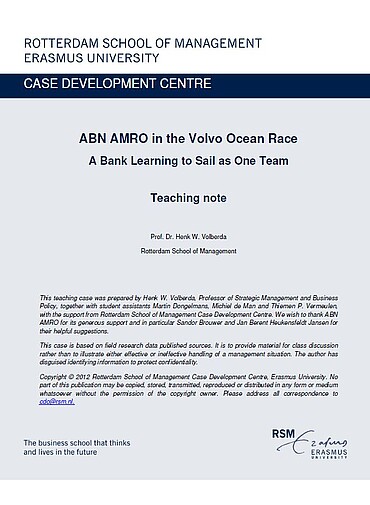Citation Note
Based on field research; 30 pages.
Follow the 'handle' link to access the Case Study on RePub.
For EUR staff members: the Teaching Note is available on request, you can contact us at rsm.nl/cdc/contact/
For external users: follow the link to purchase the Case Study and the Teaching Note.
Objective
The case describes a selection of important management challenges at three managerial levels: the top strategic level, the top managerial level of AABS (the internal implementing organisation of the sponsorship) and the operational level. By, applying ‘academic lenses’ from several domains in business administration - both implicitly and explicitly - including strategic management, international business, marketing, branding, and human resource management -, the case provides a comprehensive picture of AA’s participation in the VOR. Consequently, it can be used for educational purposes by business students at the bachelor level, as well as by master students in the mentioned fields. Given the popular context - internationalisation of the financial sector, sports sponsoring, global employee commitment, etc. -, as well as the easy-to-read style, we hope the case will also provide an interesting read to people with a general interest in these topics.
description
ABN AMRO innovatively used the Volvo Ocean Race to promote its “one bank philosophy.” While daily marketing operations were under stress, one cannot help but wonder whether this extravagant marketing technique was the best strategy for the bank.
Abstract
On 12 November 2005, two state-of-the-art sailing boats, ABN AMRO ONE and ABN AMRO TWO, left Vigo, Spain, for Cape Town, South Africa, in the prestigious Volvo Ocean Race (VOR), finishing 216 days and 31,250 nautical miles later in Gothenburg, Sweden. This was the first time that ABN AMRO (AA) had participated in a global sporting event, let alone one with a worldwide client hospitality program, including a huge traveling pavilion that attracted over a million spectators in nine countries. Furthermore, the bank made the decision not just to sponsor an existing sailing team, but also to participate in the race. Through an embedded organization called ABN AMRO Brand & Sail Company (AABS), the bank organized two new sailing teams in-house, designed and built its own boats, and developed an extensive branding and marketing campaign. AA used the race to promote its ‘one bank philosophy’ to existing and potential customers, as well as employees of all its international branches. While moving towards their goal, however, AA encountered many obstacles. Daily marketing operations in particular were under stress. One could not help but wonder whether VOR was the best way to promote the ‘one bank philosophy.’ How and to what extent did the VOR contribute to promoting the philosophy? Was it worthwhile establishing a separate company 'AABS' to achieve such results? What alternatives might AA have explored?
usage
In a popular context – internationalization of the financial sector, sports sponsoring, global employee commitment – and with an easy-to-read style, the case helps students to contemplate how to achieve strategic goals with a temporary project and by addressing challenges at all three organizational levels: the strategic level, the managerial level, and the operational level.
